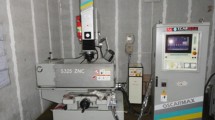Conclusions
-
1.
A study was made of the effect of structure and porosity on the erosion resistance of TiB2 in spark machining.
-
2.
It was established that the erosion resistance of TiB2 is strongly affected by its grain size. For example, growth in grain size from 10 to 50μ increases the erosion of the boride by 60% by increasing the share of the brittle fracture component in the erosion effect.
-
3.
Machining conditions affect only slightly the structure of fine-grained specimens, but, if a good surface finish is to be obtained with coarse-grained specimens, machining should be performed under soft conditions.
-
4.
It was found that the least tool electrode wear is experienced when the porosity of the material being machined lies in the range from 4 to 10%.
-
5.
The data obtained on the porosity dependence of the erosion resistance of TiB2 lead to the conclusion that tool electrodes of more than 10% porosity may prove acceptable owing to their higher erosion resistance.
Similar content being viewed by others
Literature cited
G. V. Samsonov and A. M. Lemeshko, Elektron. Obrab. Mater., No. 6 (1969).
G. V. Samsonov and I. M. Mukha, Poroshk. Metall., No. 6 (1968).
B. N. Zolotykh, in: Problems in the Electrical Machining of Materials [in Russian], Izd-vo Akad. Nauk SSSR, Moscow (1962), p. 5.
N. I. Shcherban', Poroshk. Metall., No. 9 (1973).
N. I. Shcherban', Poroshk. Metall., No. 10 (1973).
A. D. Lemeshko, “An investigation into electrode erosion in the electric spark machining of refractory metals and their compounds with carbon, boron, and nitrogen,” Candidate's Dissertation, Kiev (1972).
Fracture, Microscopic and Macroscopic Principles of Fracture Mechanics [Russian translation], Vol. 1, Mir, Moscow (1973).
G. V. Levchenko, “Sintered contacts of high interrupting power,” Author's Abstract of Candidate's Dissertation, IPM AN UkrSSR, Kiev (1964).
S. L. Mendel'shtam, M. K. Sukhodrev, and V. P. Shabanskii, “Effect of discharge circuit parameters on spark channel temperature,” Fiz. Sb. L'vovsk. Univ.,2, No. 4, 77 (1958).
Author information
Authors and Affiliations
Additional information
Translated from Poroshkovaya Metallurgiya, No. 12(168), pp. 55–59, December, 1976.
Rights and permissions
About this article
Cite this article
Verkhoturov, A.D., Koval'chenko, M.S. & Mai, M.M. Effect of structure and porosity on the erosion resistance of boride electrodes. Powder Metall Met Ceram 15, 942–945 (1976). https://doi.org/10.1007/BF01205804
Received:
Issue Date:
DOI: https://doi.org/10.1007/BF01205804



